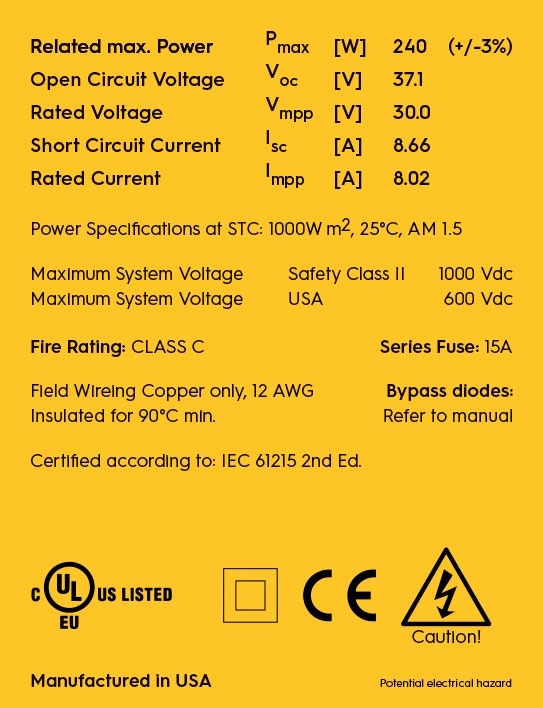Solar Power 101:
A Simple Guide to Solar Energy
If you're looking for a simple training series on solar energy, you've come to the right place. In this series we cover everything from the basics of solar energy to the components that make up solar energy systems and put it into a simple format that anyone can benefit from.
1. Solar Basics: Amps
What is an Amp?
Simply stated, an Amp is the measure of the flow of electrons (usually through a wire).
When a voltage is produced (from a solar panel, a generator, etc) it creates a force that pushes electrons through a conductor creating a current. One amp of current is approximately equal to 6.25 X 10^18 of electrons per second.
Amps can be compared to the flow of water through a pipe (which is the measure of the flow of water molecules). Water flow is usually measured in gallons per minute, and electron flow is measured in amps.

2. Electricity Basics: Power/Energy
Electricity Basics: Power/Energy
We previously learned that an amp is the rate of flow of electrons. However, amps is not a measure of power.
Let's compare electricity to weight lifting. Amps would be compared to how fast you are lifting (your reps per minute). But this does not tell the whole story. You see there is a huge difference between lifting 10 reps per minute with 10 lbs, and lifting 10 reps per minute with 200 lbs. This is where voltage comes in.
Your Amps Tell You The RATE Of Flow, And The Voltage Is The FORCE Behind That Flow (Or The Weight You Are Lifting).

Low Voltage
This weight lifter represents low voltage because he has a light weight (low force behind electrons). If he will do the same amount of work as the heavy weight lifter, he needs to move a lot faster.

Hight Voltage
This weight lifter represents low voltage because he has a light weight (low force behind electrons). If he will do the same amount of work as the heavy weight lifter, he needs to move a lot faster.
Power = Amps x Volts = Watts
As you can see from this equation, you can get more power by increasing the amps, or increasing the voltage. For example, 100 amps X 10 volts = 1000 watts. And also, 10 amps X 100 volts = 1000 watts
So, what are the advantages of one over the other? To answer that question, you need to go back to what amps are. Since amps are the flow of electrons through a wire, that means there is a limit to how many amps you can squeeze through a certain size wire. When you try to force too many electrons through a small wire, it gets hot, wasting power and creating a fire risk.
So, if you produce 1000 watts with only 10 amps and a voltage of 100V, you could use a very small wire. However, with 100 amps and 10 volts you would need a huge wire to be able to carry that many amps. This is why power lines that transport large amounts of power are usually 69,000 volts or more.
The downside to using high voltage is that it is much more dangerous. I won't go into all the details, but the higher the voltage the easier it is for you to get electrocuted. This is why we use transformers before power goes into your house lowering the voltage down to 240v, and 110v for most outlets in your home.
Power is also a rate, similar to how amps is electrons per second that is flowing through a wire. The actual SI units for power is Joules per second. However, the more common term in electricity is watts, in mechanical terms it is horse power Because power is a rate, power it is not something that is stored, just like gallons per hour is not stored. You would never say you have a 100 gallon per hour tank, or say your car puts out 300 hp per hour. Unfortunately the term watt is often used as energy(watt-hours) instead power. Have you ever herd anyone say a solar panel will put out 100 watts in an hour or say a battery is 1200 watts? That is using the term watts as energy instead of power, and is not correct.
In our weight lifting example, when you multiply your reps/hour (amps) X weight (volts). You would get a rate of power, usually calories/hour. To figure out how many calories you actually produced, you would need to multiply by the time you spent.
It is easy to see that gallons/hour or calories/hour is a rate, but it gets confusing when you see watts, which is also a rate of power, but it does not contain the per hour on it (it is similar to horse power which also is a rate but does not contain the per hour on the end of it).
This leads us to the next part which is energy. Energy is simply power over time. In weight lifting, if you're producing 100 calories/hour, for one hour, you produced 100 calories. That is pretty strait forward, but when we look at electricity, if you produce 100 watts for one hour, it becomes 100 watt-hours. This is not as intuitive because the term watts is a rate without the units of time on it like calories/hour or gallons/hour.
Power = Amps x Volts = Watts
Power:
Power cannot be stored, it is instantaneous
Has units in joules per second, or more commonly watts
Appropriate usage: Solar panels output, inverter output, appliance power usage
Commonly misused for: Battery capacity (battery capacity is watt-hours) or watts per hour (watts per hour, it not a valid unit, and does not make sense to use)
Energy:
Energy is power over time
Has units of Joules, or more commonly watt-hours
Appropriate usage: Battery storage, Power generated in a solar panel in a set amount of time (one hour, two hours, one day etc)

3. AC/DC
AC/DC
In solar, we have to deal with both AC, and DC power, because our solar panels, and batteries work with DC power, but most home appliances use AC power.
DC = Direct current
Direct current just means the flow of electrons, and the voltage stays one direction.
AC = Alternating current
With alternating current the flow of electrons, and the voltage alternate directions.
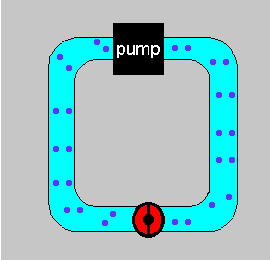
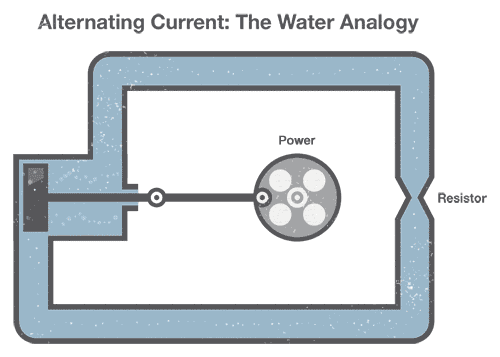
History
Almost everything we use today requires DC power: appliances, TV's, computers, LED lights, ect. Anything that uses any electronic part requires DC power. So that brings up the question, why do our homes, and all of our appliances run off of AC power from the electrical grid rather than DC power?
To answer that question we have to look back to when the power grid was developed. Initially, the only electricity we knew of was DC power. However, we didn't know how to easily convert the voltage of DC power (this is not the case now), and as a result, this the DC power could not be transported over large distances. So the plan was to build power plants on every block (within 1 mile of the end user).
Nikola Tesla invented AC power, which was very easy to convert the voltages up and back down. This made it possible to increase the voltage, to transport large amounts of energy long distances over wires, then drop the voltage down to a safe level to supply each home its power.
There was lot of debate over the choice to use AC or DC power, but in the end AC won, and we all use AC power now. At the time it was a logical choice because they did not have computer or electronics that needed DC power, and AC power was much easier to transport over long distances. And now we are stuck with the AC power grid, and every appliance that has an electronic circuit has to convert the AC power to DC power (wasting energy) to make it usable. To make it even worse, if you use solar, we need to convert the DC power to AC, so the appliance uses it, then the appliance converts it back to DC power. Each step wasting power.
Types Of Waveforms:
The power grid uses a type of waveform knows as a sine wave (sometimes called pure sine wave). This is also what appliances are designed to use. With this wave form, the voltage gradually goes from positive to negative, and back to positive.
Pure sine wave:

Pure sine wave is the most efficient form of AC power, and will work for any ac appliance. However because the electronics to convert DC power to pure sine wave AC power (pure sine wave inverter), they are not always used, and instead a less expensive modified sine wave inverter is used. A modified sine wave inverter approximates the sine wave by doing it it steps.
Modified sine wave:

The Problem with the modified sine wave is that your appliances will be less efficient, run hotter, and may not even run at all. It's comparable to driving a car with square tires. Even if they are cheaper I would not use them.

4. Solar Panels
Solar Panels
Now that we have a basic understanding of electricity we will go over the components of a solar generator. Basically a solar Generator is a portable mini off-grid system. The first component is the solar panel. The solar panels convert light (not heat) into power (voltage and current). This is the heart of the solar generator. So we are going to cover them in detail.
Types of Solar Panels:
1- Rooftop Solar Panels
These are what are usually used in grid tie or off grid systems. They are inexpensive, durable, and usually very efficient. However for portable systems they are very bulky, heavy, and not very portable.
Use: Permanent mounting on roof or stand.
2- Foldable Solar Panels
These are basically a smaller, portable version of roof top panels . They are durable and efficient and can be folded for storage and stand on their own with a built-in metal stand. They are still heavy, and can take a lot of space to store (if you have more than a 200 watts or so). They are also more expensive per-watt than the roof top panels.
Many times these panels are setup with a cheap pwm charge controller and aligator clips to charge a battery. These types of panels are designed to charge a 12V battery directly, and won't work with a solar generator unless you remove the charge controller and use appropriate connectors on the panel. It is best to find a foldable panel that is setup with just mc4 connectors, and no charge controller.
Use: For portable systems that will be used on a regular basis.
3- Light Flexible Solar Panels
These are by far the most portable solar panel. They are also very thin, making them great for storing in small spaces. However, they have been reported to be less durable, due to being flexed over and over again (usually when mounted on the roof of an rv, or such), or due to cheap panels that are not UV resistant. If these panels are used, make sure they use a good UV rated surface (ETFE). However even with the best flexible panels, they should not be used in a full time situation as they will not last as long as rooftop or foldable solar panels.
Use: Portable systems that will only be used occasionally.
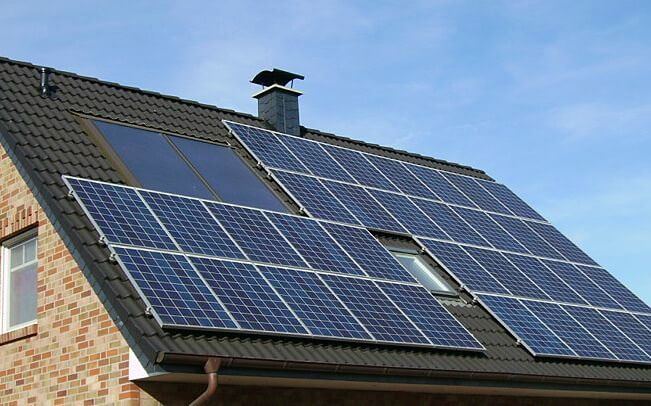
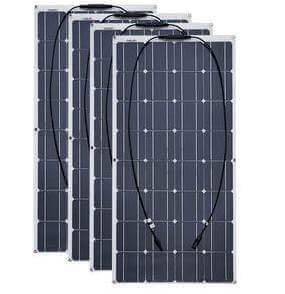
Types of Solar Panels
It is important to understand what the specs on the solar panels mean. This is especially important if you are putting together a system with your own array of solar panels.
Pmax: This is the maximum power the solar panel is rated for. If it is a 100 watt solar panel this will be 100 watts. It is important to note that the panel will only produce this power under ideal conditions with direct sun, and a low temperature (solar panels actually produce less power when the are hot). It is also important to know that some manufacturers don't get this number very accurate. This is usually with brands that are not very well known. Sometimes they actually produce more than they say, but most of the time they don't produce the rated Pmax power.
Efficiency: Many people think a higher efficiency solar panel will charge your batteries faster than a lower efficiency solar panel with the same pmax power rating. The efficiency has nothing to do with how fast it will charge. However as mentioned in the Pmax section sometimes panels don't output there rated power, and if they don't, that will effect the charge time.
The only ting efficiency effects is the size of your panel. A low efficiency solar panel will be much larger than a high efficiency solar panel of the same watt rating. A good monocrystaline solar panel will be in the 18-23% rating, which is about as high as it gets (as of writing this). Now if you get a 9% efficient solar panel it is going to take you at least twice the space in solar to produce the same output. This can hurt the portablitliy of your system.
Ipmax: This the current the solar panel will put out in amps at the maximum power output of the solar panel (when it is putting out the Pmax power). This is a good number to know, and useful when testing solar panels, but not as critical as the ISC.
ISC: This the the current when the solar panel is short circuited. Essentially this is the maximum amps the panel will put out. This number is important because you want to make sure your wires and connectors can handle this amount of amps. For example if you parallel 5 panels with a ISC of 7A (when you parralell panels the amps goes up, but the voltage stays the same) your maximum amps would be 35A.
Max System Voltage: When you parallel solar panels together the system voltage will go up. You want to make sure the voltage is not higher than the Max system Voltage. Usually this voltage is high (600-1000v), however I have seen some panels with a system voltage as low as 45v.
Voc: This is voltage open curcuit, which is the voltage of the solar panel when there is no load on it, or the maximum voltage (at the rated temperature, this voltage will go up when it is colder, and down when it is hot). If you are running solar panels in series, the voltage will increase while the amps stay the same. You want to make sure the Voc voltages don't add up to go over the charge controllers maximum voltage, or the solar panels max system voltage. For example, if the Voc is 22V, and your charge controllers maximum voltage is 100v, you would not want to run more than 4 panels in series (4×22=88V, 5×22=110). It is usally a good idea to leave some buffer in here, so if you figure your voltage at 95Voc, and your charge controller can only handle 100v, I would do 1 less panel.
Vmp: This is the voltage of the solar panel at its maximum power. At open circuit (no load) the voltage is at its maximum, but since the current is 0, it is also putting out 0 watts of power (power = volts X amps). As you put a load on the panel allowing current to flow, the voltage will start to go down as the current goes up. At short circuit, you will get your maximum amps with 0 volts. This also produces 0 watts of power. The voltage where it produces the most power is the Vmp. This voltage is under ideal conditions, and will change depending on how bright the sun is.
Solar Panel Wiring: Series/Parallel
When connecting solar panels in a series, you simply connect the positive of one panel to the negative of the other. They are designed with mc4 connectors that only connect that way. When you wire solar panels in parallel, you connect all the positive wires together, and all the negative wires together. You can also wire in both series and parallel at the same time.
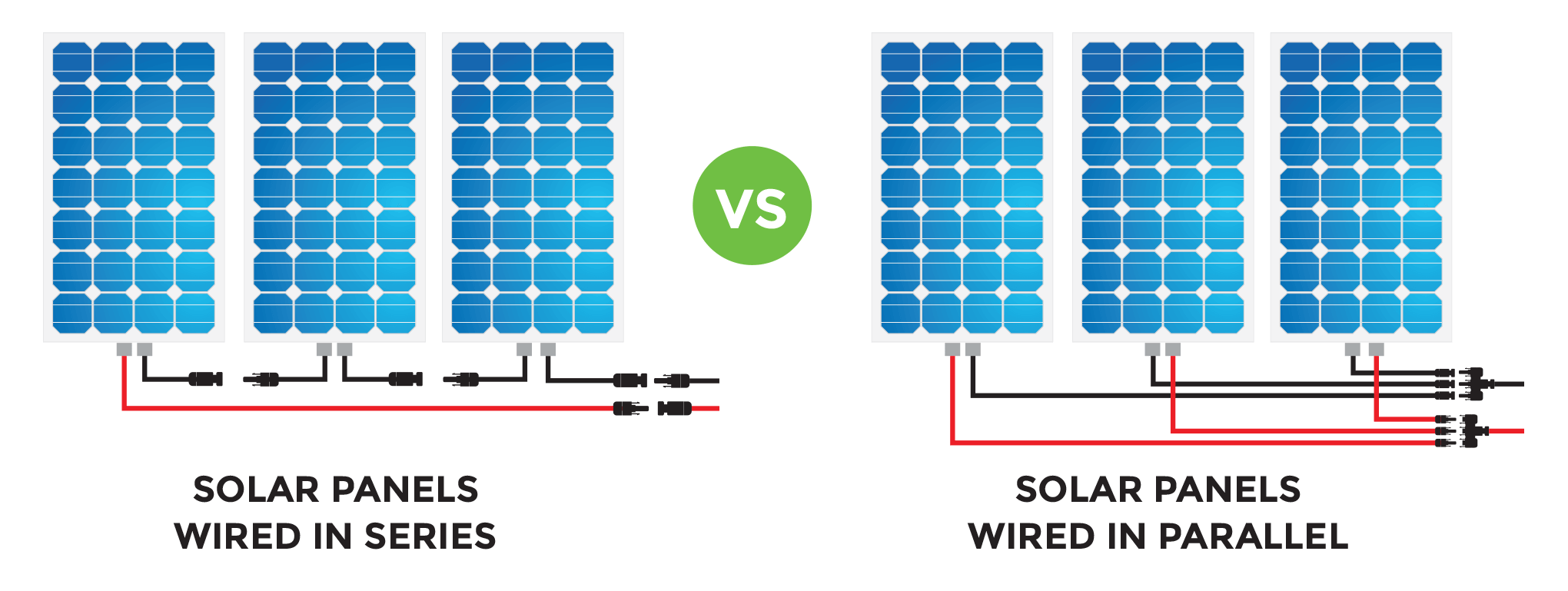
Each panel:
Pmax = 100 watts
Voc=22v
Isc=7A
Combined in series:
Pmax = 300 watts
Voc=66v
Isc=7A
Each panel:
Pmax = 100 watts
Voc=22v
Isc=7A
Combined in series:
Pmax = 300 watts
Voc=66v
Isc=7A
You can also wire your panels in series and parallel at the same time. For example if you were to series 2 panels, then series another 3 sets exactly the same, and then parallel them all together, you would have 4 series of two panels each.
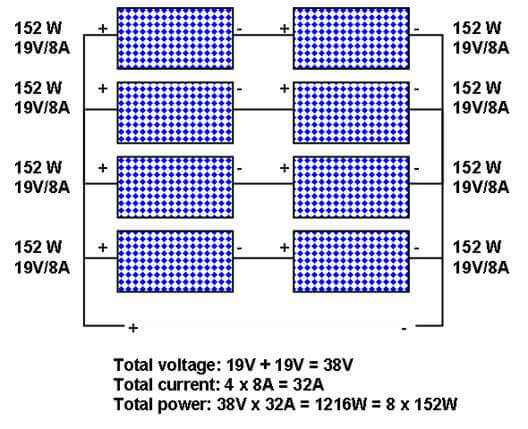
Here's What You Need To Know:
Series: You add the voltage of each panel without changing the amps
Parallel: You add the amps, without changing the voltage
In the above example, since we series two panels together the voltage is 19V +19V = 38V
And since we paralleled 4 strings (a string is a set of panels run in a series) The amps add to: 8A+8A+8A+8A = 32A
The watts will be the same no matter how they are wired. You simply add the watts of the panels. 8 panels X 152 watts = 1216 watts
5. Charge Controllers
Charge Controllers
The purpose of the charge controller is to take the power generated from the solar panels and charge the batteries. If you were to connect the solar panels directly to the batteries without a charge controller, it would end up overcharging the batteries permanently damaging them.
There are two main types of charge controllers:
1- PWM
This is the most common type of charge controller in small systems like portable solar generators, because it is very simple, light, and inexpensive. The problem is that it's not very smart. It's basically an on and off switch. It's on when the battery is low, and once the battery starts getting full, it turns off for a short period, then back on. The duration when it's off gets longer and longer until it is totally off when the battery is completely full.
2- MPPT
This type of charge controller is larger heavier, and more expensive, but it has a several important advantages over a PWM charge controller. First of all, the MPPT stands for maximum power point tracker. If you remember from the solar panel section, your solar panels have a Vmp (the voltage where they produce the most power). This is never the same voltage as the battery. A 12V solar panel usually has a Vmp of around 18V. This is because if it were at the voltage of a 12v battery (about 13V full), it would not be able to charge at all when unless there was perfect sun pointed directly at the solar panel. It would also charge slowly because the absorbed voltage (the voltage needed to charge the battery) is around 14v. The point is when you connect the battery to the solar panel with a regular PWM charge controller, it will pull the solar panel voltage down to the battery voltage, which is not the Vmp of the solar panel, and thus your solar panel will not be able to produce its rated power. The MPPT charge controller is able to find the Vmp of the solar panel (even on cloudy days when it is not the same as the rated Vmp), and keep the solar panel at that voltage to produce its maximum power. It then steps that voltage down to the battery charging voltage while at the same time increasing the charging amps. By doing this, it can actually charge your battery at the full power of the solar panels. This can increase charging by up to 40% on cloudy days when you need it the most. So a solar generator with an MPPT charge controller will actually out perform one with a PWM charge controller even if it has less solar panels. This is really good for a portable system because you can get away with less solar.
Another really nice thing about an MPPT charge controller is that, it can have a much wider range of solar input. Good charge controllers can allow for over 100V of solar, where with a PWM, you need to stay very close to the battery voltage. This means you can add more solar panels easier with an MPPT charge controller. Also, since it can regulate the current (rather than just using a switch), you can add extra solar panels and go over the output watts of the controller without any worry (on good MPPT charge controllers). So if you have a 1000 watt charge controller, you could connect 1500 watts of solar, and even though you would never produce more than 1000 watts, it will not damage anything.
Doing this can be extremely beneficial for days of cloudy weather. So for example, lets say it is cloudy or overcast, and your solar panels are only putting out 30% of there rated output with an MPPT charge controller, and 20% with a PWM charge controller. Now if you have both charge controllers rated at 500 watts of power with 500 watts of solar connected, the PWM will be putting out 100 watts, and the MPPT charge controller will be charging with 150 watts of solar (both are much lower than the 500 watts).
Now lets say you have an extra 1000 watts of solar. If you connect these extra solar panels up, the MPPT charge controller will charge at a rate of 450 watts, and PWM charge controller will charge at 300 watts (on a cloudy day). Not bad right. Well we have one little problem. What happens if a cloud moves away, and we have full sun? 1500 watts of solar is going to burn up your 500 watt PWM charge controller (or its connecting wires, etc). However the MPPT charge controller will regulate the power, and keep it at 500 watts. This way you can connect extra solar panels, and don't have to remember to unplug them when the sun comes out
Here Is What You Need To Know:
PWM charge controller:
A simple on/off switch to keep from over charging the batteries
No current or voltage regulating
Inexpensive
Light
MPPT charge controller:
Much more advanced
Voltage and current regulating
More efficient (up to 40% more efficient)
More expensive (about 5X the price of a PWM)
Heavier
6. Batteries
Batteries
The batteries are what keep you going when there is no sun. If you need to have power all the time (even during a rainy day), then you need to make sure you have enough battery capacity to keep you going. This is not critical if you are simply powering a tv, and some lights. However if you need to have power to cook on, or maybe to keep a fridge, or furnace going, then it becomes important that you don't run out of power.
This section could be an entire book. But I will keep it simple, and we will only talk about a few types of batteries.
Here's the Summary:
LEAD-ACID is a tried-and-true technology that has been used in off grid energy systems for decades. While they have a relatively shorter life span than lithium's, and are 2-3X as heavy, they are also 1/2 to 1/3 the price. They are heavy and bulky, and depending on the type, may require regular maintenance. Overall, they're a great battery for off-grid and backup systems, but are too heavy for small portable systems.
LITHIUM is a lighter, more compact battery with a longer lifespan. They do have temperature limitations and are more expensive than their lead-acid counterparts. But if weight is critical, then they are the only way to go. Out of the two main types of lithium batteries( NMC and LiFePo4), NMC is much lighter. For emergency backup power, or camping, the NMC is the best choice (because of its light weight). However if you will be running a tiny home, or cabin full time off the grid, and are not as concerned about weight, LiFePo4 has a longer life, and is a more stable battery.
7. Inverters
Inverters
The inverter is what converts DC power into usable AC power for our appliances.
There are several specs of the inverter that are important to look at.
1- Maximum continuous output:
Usually this is the rating on the inverter. However sometimes I see inverters rated out the maximum surge output (which is usually twice there continuous output). Generally you can't expand the inverter, so if you get a small inverter capable of 500 watts, you will never be able to run anything that takes more than 500 watts. However there are a few inverters (The one in the Titan solar generator is on of those) that are designed to be able to add more inverters to increase the total output. Usually these inverters are very expensive, like the Magnum inverter, or the outback inverter (both sell at over $2,000).
2- Surge power:
This is important for starting heavy loads, such as a motor (well pump, compressor, saw, etc). Generally these types of loads take twice or even 3 times there running power to start.
3- Wave type:
We talked about sine wave vs modified sine wave previously. Even though modified sine wave inverters are less expensive, I would never suggest getting one for a solar generator, or emergency power. It is worth it to pay the extra money and get a pure sine wave inverter
4- Efficiency:
There are two types of efficiency. The first is the maximum inverter efficiency, which is what most people look at, but it is a little miss leading, because the inverter is almost never this efficient. Most of the time it is lower. The more important efficiency to look at is the no load power draw. This is the minimum power your inverter will consume even when you are not running anything. Now it is important to know that the larger the inverter, the larger this power draw will be. For example, a 500 watt inverter may only draw 4 watts, where a 5,000 watt inverter will draw 40 watts. It is kind of like comparing a Geo metro with a v10. The v10 will be burning a lot more fuel at addle than the Geo metro. A good rule of thumb is that it should not pull more than 1% of its rated continuous output.
8. Quiz
Results
I am sorry, you did not pass the test this time. Please review and take again.
#1. Please choose the most accurate description of what an amp is
#2. Aproximatly how much energy would a 100 watt solar panel produce in 5 hours of sun
#3. Approximatly how much energy does a 100ah 12v battery store
#4. Approximatly how many amps would you draw from a 12v battery to produce 120 watts of power
#5. What is the difference between power and energy
#6. What is a correct unit for the stored energy in a battery
#7. What are the correct units for Energy generated by a solar panel in one hour
#8. Power(watts) X time(hours) = Energy (watt-hours)
Use the following label for the next 3 questions
